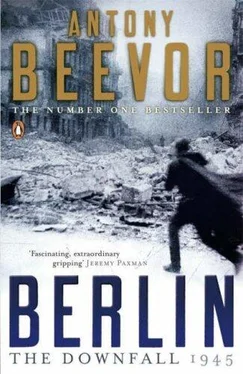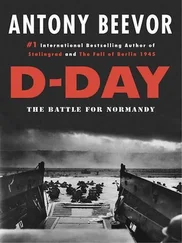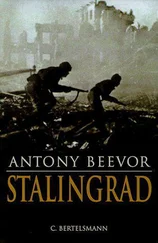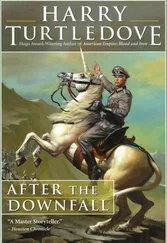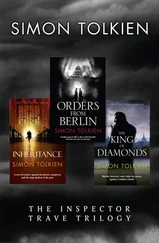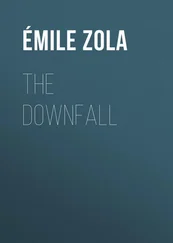There were no troops in the area except for a few Volkssturm companies armed with nothing more than rifles and a couple of panzerfausts. Commanded by an old headmaster, they kept their distance. They found that Soviet snipers had climbed into the oak trees. An alarm battalion of anti-Soviet Caucasians, stiffened with some Germans from the 6th Fortress Regiment, was hurried to the spot from Frankfurt. Beier, as a frontline soldier, was put in charge of a group by an officer.
While Beier was observing the wood with them from a ditch, one of the Caucasians pointed at it and said in broken German, ‘You no shoot, we no shoot there. We no shoot at comrades.’ Beier reported this and the Caucasians were disarmed and sent back from the front line to dig trenches instead. Their fate, when captured later by the Red Army, would not have been softened by this refusal to fire at their own countrymen.
The scratch German force was joined by a group of very young trainee soldiers of the Panzergrenadier Division Feldherrnhalle. Most of them were between sixteen and eighteen years old. They began to mortar the oak wood, one of the few patches of deciduous woodland in the area. There were around 350 of them in a chaotic array of uniforms. Some had steel helmets, some had Käppis, or sidehats, others wore peaked caps. Many had nothing more than their Hitler Youth uniforms. They were intensely proud of their task, yet many of them could hardly pick up a full ammunition box, and they could not hold the rifles properly into the shoulder, because the butts were too long for their arms. On their first attack, the Soviet sharpshooters picked them off with deliberate aim. The unit commander fell with a bullet through the head. Only a handful of the soldiers returned alive.
Beier managed to slip back to his parents’ house. He found that a dressing station had been set up in the cellar and all their sheets were being torn up for bandages.
More weighty reinforcements arrived to attack the bridgehead as Chuikov’s men pushed forward to seize the Reitwein Spur, a commanding feature which looked up the whole Oderbruch and across to the Seelow Heights on its western edge. On 2 February the 506th SS Heavy Mortar Battalion moved north to the edge of the bridgehead and in three days and nights it fired 14,000 rounds. A battalion of the Kurmark Panzer Regiment was also brought up. On 4 February the battalion, recently re-equipped with Panther tanks, was sent in to attack the Reitwein Spur from its southern end. The tanks, however, failed disastrously because the thaw predicted by meteorologists had started, and they slipped and slithered on the muddy hillsides.
* * *
News of Red Army troops crossing the Oder shocked Berlin. ‘ Stalin ante portas! ’ wrote Wilfred von Oven, Goebbels’s press attaché, in his diary on 1 February. ‘This cry of alarm runs like the wind through the Reich capital.’
National Socialist rhetoric became fanatical, if not hysterical. The guard regiment of the Grossdeutschland Division was paraded. They were told that the Oder bridgeheads must be recaptured for the Führer. Berlin city buses drove up and they were taken out to Seelow, over-looking the Oderbruch.
A new SS Division was also formed. It was to be called the 30. Januar in honour of the twelfth anniversary of the Nazis taking power. This division was given a core of SS veterans, but many of them were convalescent wounded. Eberhard Baumgart, a former member of the SS Leibstandarte at a recuperation camp, received orders to parade along with the other SS invalids. An Obersturmführer told them of the new division. Its task was to defend the Reich’s capital. The new division needed battle-hardened veterans. He called on them to volunteer and yelled the SS motto devised by Himmler at them: ‘Unsere Ehre heisst Treue, Kameraden!’ — ‘Our honour is called loyalty.’
Such fanaticism was becoming rare, as senior members of the SS recognized with alarm. On 12 February, Obergruppenführer Berger reported to Himmler that the organization was becoming thoroughly disliked both by the civil population and by the army, which strongly resented its ‘marked uncomradely attitude’. The army, he concluded, was ‘no longer on speaking terms with the SS’.
Even SS volunteers felt enthusiasm dissolving when they reached the Oderbruch, a dreary expanse of waterlogged fields and dykes. ‘We’re at the end of the world!’ one of the group earmarked for the 30. Januar announced. They were even more dispirited to find that this new formation had no tanks or assault guns. ‘This is no division,’ the same man remarked, ‘it’s a heap that’s just been scraped together.’ Because of his unhealed wounds, Baumgart was attached as a clerk to divisional headquarters, which was established in a requisitioned farmhouse. The young wife of a farmer, who was serving somewhere else, watched in a daze as their furniture was manhandled out of the parlour and field telephones and typewriters were installed. The new inhabitants soon discovered, however, that the tile-roof of the farmhouse provided a clearly visible target for Soviet artillery.
Baumgart found himself hunched over one of the typewriters, bashing out reports of interviews with three Red Army deserters. They had apparently decided to cross to the German lines after being made to wade through the icy waters of the Oder, carrying their divisional commander on their shoulders to keep him dry. The Volga German interpreters at divisional headquarters later read out articles from captured copies of Pravda. The communiqué published at the end of the Yalta conference described what the allies intended to do with Germany. The idea of defeat appalled Baumgart and his comrades. ‘We simply have to win in the end!’ they said to themselves.
On 9 February 1945, the anti-Soviet renegade General Andrey Vlasov, with Himmler’s encouragement, threw his headquarters security battalion into the bridgehead battle. This Russian battalion, as part of the Döberitz Division, attacked the Soviet 230th Rifle Division in the bridgehead just north of Küstrin. Vlasov’s guard battalion fought well, even though the attempt was unsuccessful. The German propaganda account described them as fighting with ‘enthusiasm and fanaticism’, proving themselves as close-quarter combat specialists. They were supposedly given the nickname ‘ Panzerknacker’ by admiring German units, but this may well have been the touch of a popular journalist turned propagandist. Their commander, Colonel Zakharov, and four men received the Iron Cross second class, and the Reichsführer SS himself sent a message to congratulate Vlasov ‘with comradely greetings’ on the fact that his guard battalion had ‘fought quite outstandingly well’.
Such marks of favour to those who had previously been categorized and treated as Untermenschen was a good indication of Nazi desperation, even if Hitler himself still disapproved. On 12 February, Goebbels received a delegation of Cossacks ‘as the first volunteers on our side in the battle against Bolshevism’. They were even treated to a bottle of ‘ Weissbier’ in his offices. Goebbels praised the Cossacks, calling them ‘a freedom-loving people of warrior-farmers’. Unfortunately, their freedom-loving ways in north Italy brought to Berlin bitter complaints about their treatment of the population in the Friuli district from the German adviser for civil affairs. The Cossacks, however, refused to have anything to do with Vlasov and his ideas of old Russian supremacy, as did most of the SS volunteers from national minorities.
The Führer’s response to the onrush of Soviet tank brigades towards Berlin had been to order the establishment of a Panzerjagd Division, but in typical Nazi style, this impressive-sounding organization for destroying tanks failed to live up to its title. It consisted of bicycle companies mainly from the Hitler Youth. Each bicyclist was to carry two panzerfaust anti-tank launchers clamped upright either side of the front wheel and attached to the handlebars. The bicyclist was supposed to be able to dismount in a moment and be ready for action against a T-34 or Stalin tank. Even the Japanese did not expect their kamikazes to ride into battle on a bicycle.
Читать дальше
